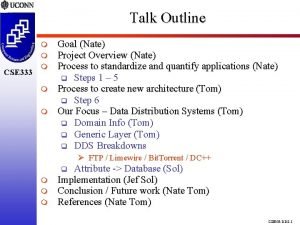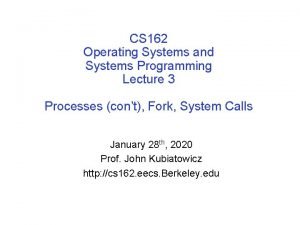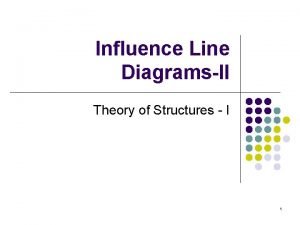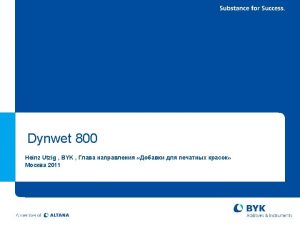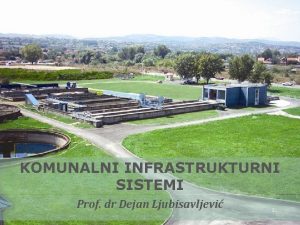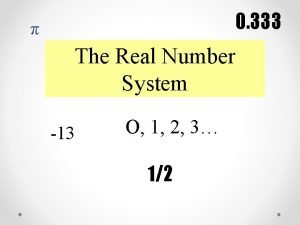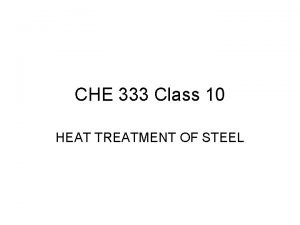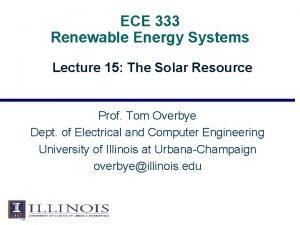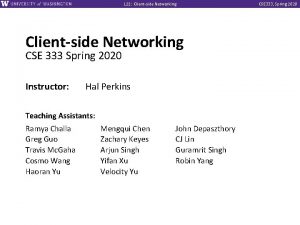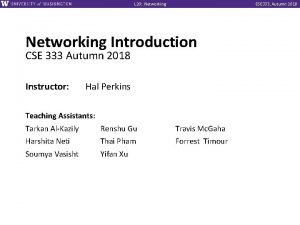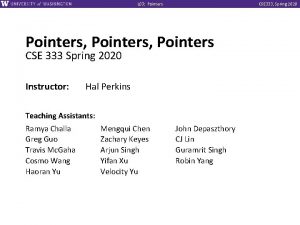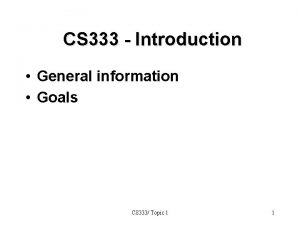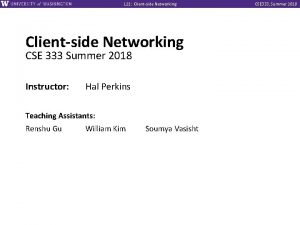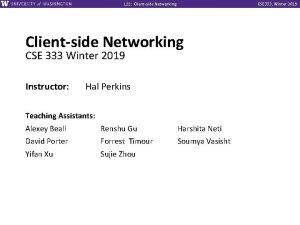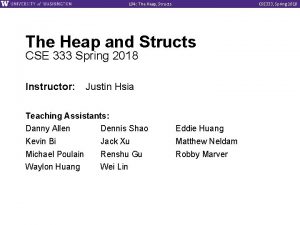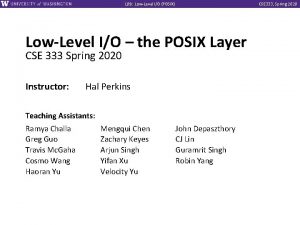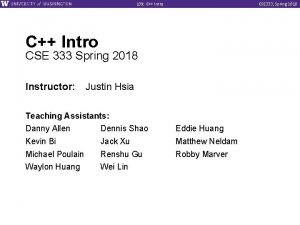L 20 Networking CSE 333 Spring 2020 Networking





















- Slides: 21

L 20: Networking CSE 333, Spring 2020 Networking Introduction CSE 333 Spring 2020 Instructor: Hal Perkins Teaching Assistants: Ramya Challa Greg Guo Travis Mc. Gaha Cosmo Wang Haoran Yu Mengqui Chen Zachary Keyes Arjun Singh Yifan Xu Velocity Yu John Depaszthory CJ Lin Guramrit Singh Robin Yang

L 20: Networking CSE 333, Spring 2020 Administrivia v No exercises due for a while! § First networking exercise out next Thursday, due following Monday • v DNS and TCP client-side (covered in class/sections next week); somewhat longer than usual exercise, but good warmup for hw 4 hw 3 due next Thursday night § Usual reminders: don’t forget to tag, then be sure to clone elsewhere and recompile / retest § Usual latedays apply (if you have any left – be sure to check) 2

L 20: Networking CSE 333, Spring 2020 Administrivia v Rest of the quarter: § Topics: Networking; Concurrency, Processes, and Threads § A few more exercises (~3) • Networking client side, server side, concurrency § hw 4: file-search web server • Out next week; due Thursday, June 4 (last week of classes) • Demo in class next week 3

L 20: Networking CSE 333, Spring 2020 Lecture Outline v Introduction to Networks § Layers upon layers… 4

L 20: Networking CSE 333, Spring 2020 Networks From 10, 000 ft clients servers 5

L 20: Networking CSE 333, Spring 2020 The Physical Layer v Individual bits are modulated onto a wire or transmitted over radio § Physical layer specifies how bits are encoded at a signal level § Many choices, e. g. , encode “ 1” as +1 v, “ 0” as -0 v; or “ 0”=+1 v, “ 1”=-1 v, … 0101 computer NIC physical copper wire optical cable radio frequency band computer NIC physical 6

L 20: Networking CSE 333, Spring 2020 The Data Link Layer v Multiple computers on a LAN contend for the network medium § Media access control (MAC) specifies how computers cooperate § Link layer also specifies how bits are “packetized” and network interface controllers (NICs) are addressed 00: 1 d: 4 f: 47: 0 d: 48 4 c: 44: 1 e: 8 f: 12: 0 e 7 a: 37: 8 e: fc: 1 a: ea de: ad: be: ef: ca: fe 01: 23: 32: 10: ab: ba computer computer NIC NIC NIC ethernet data link physical destination address source address ethernet header data ethernet payload 7

L 20: Networking CSE 333, Spring 2020 The Network Layer (IP) v Internet Protocol (IP) routes packets across multiple networks § Every computer has a unique IP address § Individual networks are connected by routers that span networks 128. 95. 10. 55 128. 95. 10. 72 128. 95. 10. 95 host ethernet 128. 95. 10. 1 router ethernet 128. 95. 4. 1 network data link physical host 128. 95. 4. 3 128. 95. 4. 10 128. 95. 4. 12 8

L 20: Networking CSE 333, Spring 2020 The Network Layer (IP) v There are protocols to: § Let a host map an IP to MAC address on the same network § Let a router learn about other routers to get IP packets one step closer to their destination source network data link physical 9

L 20: Networking CSE 333, Spring 2020 The Network Layer (IP) v Packet encapsulation: § An IP packet is encapsulated as the payload of an Ethernet frame § As IP packets traverse networks, routers pull out the IP packet from an Ethernet frame and plunk it into a new one on the next network IP header destination address source address ethernet header network data link physical IP payload data ethernet payload 10

L 20: Networking CSE 333, Spring 2020 The Transport Layer (TCP) v Transmission Control Protocol (TCP): § Provides applications with reliable, ordered, congestion-controlled byte streams • Sends stream data as multiple IP packets (differentiated by sequence numbers) and retransmits them as necessary • When receiving, puts packets back in order and detects missing packets § A single host (IP address) can have up to 216 = 65, 535 “ports” • Kind of like an apartment number at a postal address (your applications are the residents who get mail sent to an apt. #) transport network data link physical 11

L 20: Networking CSE 333, Spring 2020 The Transport Layer (TCP) v Packet encapsulation – one more nested layer! src, dst, port TCP payload + seq # TCP header IP header ethernet header TCP chunk 1 IP header IP payload ethernet header ethernet payload transport TCP chunk 2 IP payload ethernet payload transport network data link physical 12

L 20: Networking CSE 333, Spring 2020 The Transport Layer (TCP) v Applications use OS services to establish TCP streams: § The “Berkeley sockets” API • A set of OS system calls § Clients connect() to a server IP address + application port number § Servers listen() for and accept() client connections § Clients and servers read() and write() data to each other transport network data link physical 13

L 20: Networking CSE 333, Spring 2020 The Transport Layer (UDP) v User Datagram Protocol (UDP): § Provides applications with unreliable packet delivery § UDP is a really thin, simple layer on top of IP • Datagrams still are fragmented into multiple IP packets transport network data link physical 14

L 20: Networking CSE 333, Spring 2020 The (Mostly Missing) Layers 5 & 6 v v Layer 5: Session Layer § Supposedly handles establishing and terminating application sessions § Remote Procedure Call (RPC) kind of fits in here Layer 6: Presentation Layer § Supposedly maps application-specific data units into a more networkneutral representation § Encryption (SSL) kind of fits in here presentation session transport network data link physical 15

L 20: Networking CSE 333, Spring 2020 The Application Layer v Application protocols § The format and meaning of messages between application entities § Example: HTTP is an application-level protocol that dictates how web browsers and web servers communicate • HTTP is implemented on top of TCP streams application presentation session transport network data link physical 16

L 20: Networking CSE 333, Spring 2020 The Application Layer v Packet encapsulation: HTTP header TCP header IP header destination address source address ethernet header HTTP payload (e. g. chunk of HTML page) TCP payload IP payload data ethernet payload 17

L 20: Networking CSE 333, Spring 2020 The Application Layer v Packet encapsulation: ethernet header IP header TCP header HTTP payload (e. g. chunk of HTML page) 18

L 20: Networking CSE 333, Spring 2020 The Application Layer v Popular application-level protocols: § DNS: translates a domain name (e. g. www. google. com) into one or more IP addresses (e. g. 74. 125. 197. 106) • Domain Name System • An hierarchy of DNS servers cooperate to do this § HTTP: web protocols • Hypertext Transfer Protocol § SMTP, IMAP, POP: mail delivery and access protocols • Secure Mail Transfer Protocol, Internet Message Access Protocol, Post Office Protocol § SSH: secure remote login protocol • Secure Shell § bittorrent: peer-to-peer, swarming file sharing protocol 19

L 20: Networking CSE 333, Spring 2020 netcat demo (if time) v netcat (nc) is “a computer networking utility for reading from and writing to network connections using TCP or UDP” § https: //en. wikipedia. org/wiki/Netcat § Listen on port: nc -l <port> § Connect: nc <IPaddr> <port> • Local host: 127. 0. 0. 1 20

L 20: Networking CSE 333, Spring 2020 The Future of Networking? 21
 Cse333
Cse333 Cse333 hw3
Cse333 hw3 Sdn introduction
Sdn introduction Kim ki duk spring summer fall winter
Kim ki duk spring summer fall winter Spring summer autumn winter months
Spring summer autumn winter months Cs162 spring 2020
Cs162 spring 2020 Spring io conference 2020
Spring io conference 2020 Math enrichment spring 2020
Math enrichment spring 2020 Ofc <333
Ofc <333 333
333 333 riverside drive
333 riverside drive Byk 333
Byk 333 Non equilibrium heat treatment
Non equilibrium heat treatment Refulirani pesak
Refulirani pesak Geo 333
Geo 333 Real numbers band
Real numbers band Ece 333
Ece 333 Che 333
Che 333 Uiuc ece 333
Uiuc ece 333 Battle of issus date
Battle of issus date Spruch iller lech isar inn
Spruch iller lech isar inn Komax gamma 333 pc manual
Komax gamma 333 pc manual
